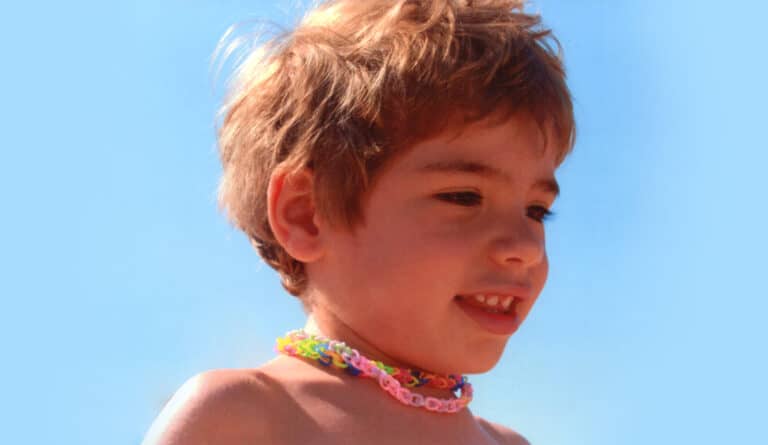After a bath, the very same thing happened, again. The First Aid Point called for an ambulance to take us to the nearest hospital. The day after we were at home, again. Why? All the examinations (EEG etc.) said there was nothing wrong. I can still remember today what they told us. Not the exact words, but the meaning. We could continue our holiday, there was no reason to worry about those two episodes. Anyway, for greater security, they told us to come back after four days to talk with a neurologist. She was out of the office that day.
We didn’t go back to the hospital. Never. After a quiet day, Leonardo suddenly had a strong seizure. It was clear, at that point, that the best thing to do was to come back home to Italy. We put together our luggage in a hurry and immediately drove back to Milan. At the hospital, after an EEG, they gave us a precise diagnosis: epilepsy. Focal epilepsy. Abnormal electrical activity, and so seizures, was starting in a limited area of the brain. That word — focal — had no particular meaning for us at that moment. We were only thinking that our son, in good health till some days before, suddenly was ill. Difficult news to accept. But that word, focal, become later fundamental.
Leonardo started his pharmacological therapy, and we tried to rearrange our days accordingly. As days and weeks passed by, it became clear that something wasn’t going the right way. Finding the right drugs and doses for each patient is a thing that requires time. They told us. We were so prepared to wait for some time, hoping drugs would solve the situation sooner or later. There isn’t only one kind of epilepsy, you know (and we know, know. But we didn’t know at that time). Some of them turn out well after their teenage years, and some drugs can control others. We were hopeful.
Unfortunately, seizures didn’t reduce. On the contrary, they were increasing in number and Leonardo started using less his left arm. In October, they decided to have another MRI scan. It was clear that Leonardo was drug resistant. At the hospital, the night before the MRI, seizures started to increase in number and intensity. In the morning the situation was getting worse and worse. Leonardo was no longer able to recover from seizures, so they put him into an induced pharmacological coma.
Days passed, but the situation wasn’t going any better. They were changing medicines and doses, but Leonardo was still in a coma. Our hopes started fading out. Then, a spark in the dark: maybe Leonardo could have brain surgery. When seizures start from a very limited area of the brain, and surgery doesn’t create too many — or too strong — impaired functions, this can be the way.
Waiting for the transfer to the new hospital, the Niguarda Ca’ Granda, was draining. Patients don’t usually have surgery when they are in a coma, so they had to arrange a lot of things before transferring Leonardo. Never-ending days, literally. Finally, after more than fifteen days he was in a coma, Leonardo went to the Niguarda Hospital. He had brain surgery at the “Claudio Munari” Surgery Center for Epilepsy. That surgery is the reason why Leonardo is still with us today.
Our story has a happy ending, or we can say so at least in part. The long stay in the Intensive Care Unit is the reason why Leonardo still today has some motor problems. And this is, for instance, one of the reasons why an early evaluation for surgery is fundamental.
During the following months, seizures came back, again. We knew that seizures usually don’t stop immediately. In fact, Leonardo was still taking drugs. It takes time for things to get better. The situation wasn’t ideal, but we were confident in a better future. Unfortunately, the seizures didn’t stop. They increased in number, again. I have to say that today Leonardo is still a happy and lively kid. Seizures are not “only a few”, I have to say it. But Leonardo’s life is normal when he’s fine. In November 2015, he went again to the Niguarda hospital for an examination we hadn’t been able to do before. A second surgery, in fact, since it’s based on intracerebral electrodes for a long-term monitoring StereoEEG. An examination they couldn’t do in November 2013 due to the emergency situation. In a small number of patients (less than 35%), non-invasive techniques fail to precisely confirm a focal onset of the seizures. They need more specific EEG monitoring, implanting these thin electrodes into the skull.
To prepare Leonardo for this examination we created a short comic: petitleò and the magic turban. A second surgery was not that easy to accept for a then 5-year-old kid coming from some difficult months.
Unfortunately, no good news from this long-term monitoring StereoEEG. Leonardo couldn’t have a second surgery, because the risks of permanent impairments were — and still are today — too high.
But this is something that can’t cancel a fundamental fact: the surgery Leonardo had in 2013 saved his life. And this is the reason why we later decided to organize a fundraiser for the “Claudio Munari” center. And why we’re still giving our support, no matter how small, whenever we can. Because it’s fundamental to spread the voice about epilepsy, so creating a culture that fights the stigma, while great agencies like CURE Epilepsy keep working for finding new ways to successfully beat epilepsy.





